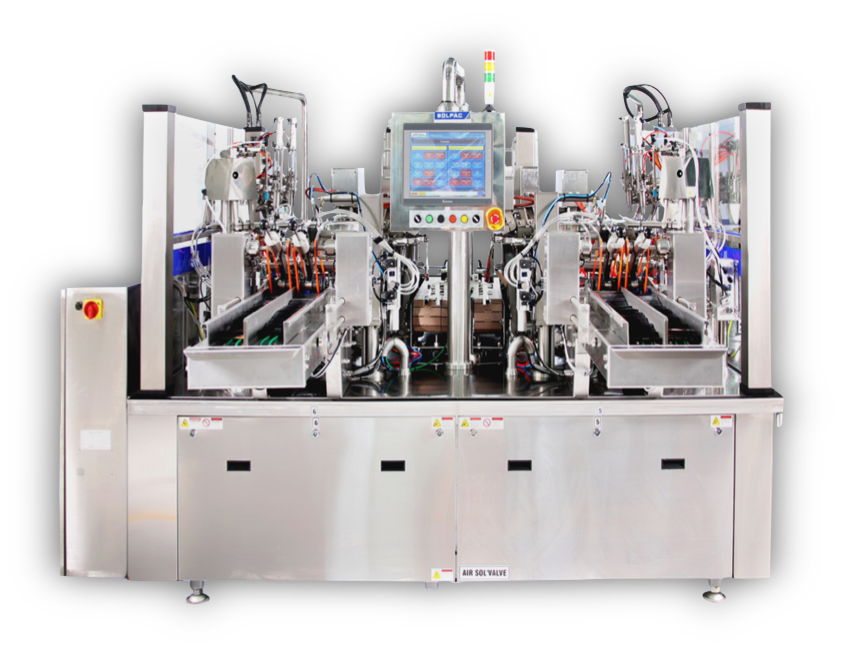How do Automatic Pouch Filling Machines Work?
By Rick Leonhard on July 31, 2017

Automatic pouch filling machines are becoming increasingly popular today for their simplicity, ease-of-use, and the superior aesthetics of their finished product. Whether you are new to packaging automation or are considering adding premade pouch packaging to your product lineup, you are probably interested in how these machines operate. Today we are taking a step-by-step look into the processes involved in turning an empty premade pouch into a shelf-ready finished product.

Pouch packing machines can be designed with an inline or rotary layout. For the purpose of today's article, we are diving deeper in to the rotary layout. This design conserves plant floorspace and is constructed with ergonomics top-of-mind, and thus is seeing more popularity than inline models.
Simplified, rotary automatic pouch filling machines grip a preformed pouch, fill it with product, and seal it, at speeds of up to 200 bags per minute. This process involves moving the bag in an intermittent rotary fashion to different 'stations' positioned in a circular shape. Each station performs a different packaging task. There are usually between 6 and 10 stations, with 8 being the most popular configuration. Automatic pouch filling machines can also be designed with a single lane, two lanes, or four lanes. Here is how the packaging process works:
 1. Bag Loading
1. Bag Loading
Preformed pouches are loaded manually by an operator into the bag magazine in the front of the machine. The bags are conveyed into the machine by a bag feeding roller.
2. Bag Gripping
 When a bag is detected by a proximity sensor, a vacuum bag loader picks up the pouch and transfers it to a set of grippers, which will hold the bag as it travels around the rotary unit to different 'stations'.
When a bag is detected by a proximity sensor, a vacuum bag loader picks up the pouch and transfers it to a set of grippers, which will hold the bag as it travels around the rotary unit to different 'stations'.
These grippers can continually support up to 10 kg on the best automatic premade pouch packing machine models.
3. Optional Printing/Embossing
If printing or embossing is desired, that equipment will be placed at this station. Pouch filling machines can utilize both thermal and inkjet printers. The printer can place desired date/lot codes on the pouches. The embossing option places raised date/lot codes into the bag seal.
4. Zipper or Bag Opening & Detection
 If the bag has a zipper reclosure, a vacuum suction pad opens the lower part of the preformed pouch and opening jaws catch the topside of the bag. The opening jaws separate outward to open the top of the bag and the premade pouch is inflated by an air blower. If the bag does not have a zipper, the vacuum suction pads still open the bottom part of the pouch but only the air blower is engaged.
If the bag has a zipper reclosure, a vacuum suction pad opens the lower part of the preformed pouch and opening jaws catch the topside of the bag. The opening jaws separate outward to open the top of the bag and the premade pouch is inflated by an air blower. If the bag does not have a zipper, the vacuum suction pads still open the bottom part of the pouch but only the air blower is engaged.
Two sensors are present at the bottom of the bag to detect its presence. If a bag is not detected, the filling and sealing stations will not engage. If a bag is present but not placed correctly, it will not be filled and sealed and instead stay on the rotary apparatus until the next cycle.
5. Bag Filling
 Product is dropped down a bag funnel into the bag, usually by a multi-head scale. For powder products, an auger filler is used. In the case of liquid applications, product is pumped into the bag by a liquid filler with nozzle. The filling apparatus is responsible for the correct measurement and release of discrete quantities of product to be dropped in to each premade pouch.
Product is dropped down a bag funnel into the bag, usually by a multi-head scale. For powder products, an auger filler is used. In the case of liquid applications, product is pumped into the bag by a liquid filler with nozzle. The filling apparatus is responsible for the correct measurement and release of discrete quantities of product to be dropped in to each premade pouch.
Options at the filling station include:
- Gas flush. This modified atmosphere packaging (MAP) process displaces oxygen within the bag by using a blast of gas, usually nitrogen. This is done immediately prior to filling the bag with product to ensure maximum displacement.
- Dust collection. For dusty or messy products, a dust hood is placed above the filling station that collects airborne particles.
6. Product Settling or Other Options
Sometimes loose contents need to settle to the bottom of the bag before sealing. This station shakes the premade pouch to achieve that.
Other options at this station include:
- Second liquid seal. For liquid applications, this station can be used for a second liquid seal to ensure maximum seal integrity.
- Second filling station. For products that include both solid and liquid components, a second filling station can be added here.
- Load shelf. For heavy fills, a shelf can be added after filling to bear the load of the extra weight and take the stress off of the gripping arms.
 7. Bag Sealing & Deflation
7. Bag Sealing & Deflation
A hot seal bar closes on the upper part of the pouch. Remaining air is squeezed out of the bag by two deflator components before sealing occurs.
8. Cooling & Discharge
A cooling bar passes over the seal to strengthen and flatten it. The finished bag is then discharged into a receptacle or onto a conveyor and can be transported to downline equipment like check weighers, x-ray machines, case packing, or carton packing equipment.
Related Posts

Delivering packaging excellence: How Big Easy Blends improved quality with packaging automation

Optimizing packaging efficiency: The role of Flow Wrapping Machines in integrated systems
